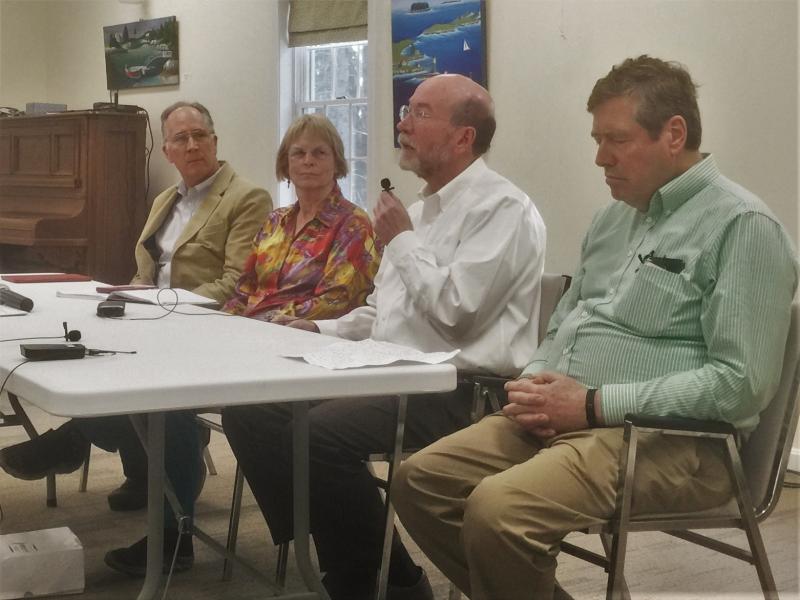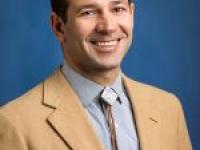Indivisible Boothbay hosts healthcare panel
The impact of Medicare and Medicaid changes was among the topics March 27 when Indivisible Boothbay hosted a healthcare panel at the Rotary Club of Boothbay Harbor.
Panelists were LincolnHealth CEO Jim Donovan, practitioner Dr. Alan Barker, elder care and telemedicine specialist Dr. Chip Teel and Boothbay Region Health Care president of the board of directors Patty Seybold. The panel discussed issues including budget cuts, the coexistence of large and small healthcare systems, how changes to Medicare and Medicaid will affect people and healthcare systems, and how LincolnHealth and MaineHealth deal with patients who have no health insurance.
Barker said he sees a broken system. He has high regard for administrators and believes they are an important part of the system. But he said it's staggering that over the past 40 years, the number of physicians has grown about 200 percent while the number of administrators has increased 3,500 percent. "I think that speaks to some of the healthcare cost.”
Donovan said in his 40 years as a healthcare administrator, he can attest to Barker’s statistics, though he did not call the system broken like Barker did. Donovan said healthcare as we know it is a “non-system” composed of decades of evolution involving policies healthcare providers and insurance companies have no hope to understand or best implement.
“(This) tells me it’s not going to be fixed in a short period of time,” said Donovan. “We truly have a dis-integrated healthcare system.”
The two concepts that occupy most of Donovan’s time are access and integration. Donovan said he is constantly asking himself how organizations can work together to maintain seamless access and integration for the benefit of the patient.
Seybold said learning how insurance companies work has been difficult.
“While we knew that theoretically, going through it has been sobering to say the least, but we’re not daunted by that …”
Seybold said the board approached the establishment of Boothbay Region Health Center as taking a broken healthcare system as a given, but moving forward despite that.
“Let’s just do it anyway and see if we can provide local primary care that is affordable and accessible and make sure that we do it with good quality and that we constantly improve based on what patients need,” Seybold said.
According to Seybold, Maine spends about $9,000 on healthcare per capita between care and prescriptions, and five percent goes to primary care. Seybold said if Maine were to increase the money spent on primary care to 10 percent, it would save about $2,000 per person.
Teel said a grassroots effort to decide what aspects of healthcare are important will be the only way to bring change, but some things have not changed through the years. In 1950, the average primary care doctor saw 18 to 20 patients a day and by 1970, the figures remained the same.
“I think if you asked Alan or I, on a busy day, we’re probably seeing 18 to 20 patients a day,” said Teel. “… It takes time to talk to people, to listen to people, to problem-solve, and then to make a plan. That’s not going to change.”
Teel said Mainecare needs to be part of the solution. Since the inception of the Affordable Care Act, Maine has created a problem by not expanding Mainecare and, thus, has been frozen for 21 to 64 year olds. The problem deepens because people in that age group who are denied by Mainecare are forced to seek insurance on the market, Teel said. The market, in turn, often refers patients back to Mainecare because they make so little to qualify and should, theoretically, be able to qualify for their state’s Medicare program.
Impressed that nearly every patient for the past 30 years on Mainecare has been happy with their care, Teel said that, perhaps, expanding Medicare as a solution to some of these issues should be on the table.
About 15 years ago, Teel investigated how much his average patients were paying per month for their health insurance and how much money his practice was making per month from the average patient. Teel discovered that while patients were paying between $500 and $1,500 per month, he was only receiving about $25.
As a result, many physicians are moving toward “direct primary care,” a model that cuts out the insurance company and provides services for patients in return for a monthly fee, often the same percentage the physician and his or her office receive from insurance companies, Teel said. It allows for more time with patients, a lower overhead and the ability to make more money seeing a quarter of the patients they used to see.
The panelists agreed it presents its own problems, like patients being unable to afford the extra fee in addition to insurance expenses; regardless of insurance coverage, most are willing to spend a little extra for better care when the opportunity is presented to them.
Indivisible Boothbay meets on the fourth Tuesday of every month.
Event Date
Address
United States
























